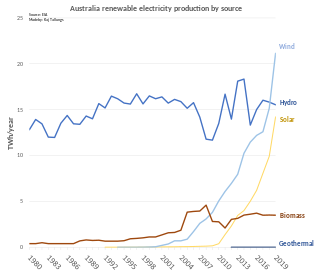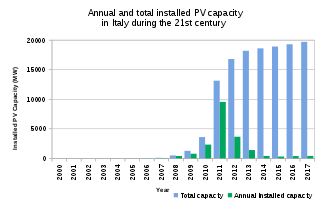Solar energy

In 2007, Tuvalu was getting 2% of its energy from solar, [12] through 400 small systems managed by the Tuvalu Solar Electric Co-operative Society. These were installed beginning in 1984 and, in the late 1990s, 34% of families in the outer islands had a PV system (which generally powered 1-3 lights and perhaps a few hours a day of radio use). [9] Each of the eight islands had a medical center with a PV-powered vaccine refrigerator and each island's solar technician had a larger PV system which ran a household refrigerator. Followup on the installations showed no deterioration of the PV panels but switches and light fixtures had suffered damage or failed from the salt air.
The implementation of the Tuvalu Solar Power Project in 2008–9, involved the installation of a 40 kW grid-connected solar system that is intended to provide about 5% of Funafuti’s peak demand, and 3% of TEC's annual household consumption. [2] The first large scale system in Tuvalu was a 40 kW solar panel installation on the roof of Tuvalu Sports Ground. [13] [14] This grid-connected 40 kW solar system was established in 2008 by the E8 and Japan Government through Kansai Electric Company (Japan) and contributes 1% of electricity production on Funafuti. [1] Future plans include expanding this plant to 60 kW.
A 46 kW solar installation with battery storage at the Motufoua Secondary School on Vaitupu island was brought online on 27 November 2009. [15] At the date of installation it was described as the largest diesel-solar photovoltaic (PV) hybrid electricity system in the South Pacific. [16] Prior to the installment of the system the residential school relied upon a diesel powered generator, which needed to be turned off during the night. The hybrid system systems saves thousands of dollars in diesel costs and provides the school with a 24-hour supply of energy, with up to 200 kWh per day. [16] [17]
Funding for further PV solar system grid-tied systems was announced in late 2011 for Funafuti, with the funding provided by the Pacific Environment Community (PEC) Fund. [18] In 2015 a New Zealand aid programme resulted in Solarcity and Infratec Renewables, two New Zealand companies, installing photovoltaic panels on government buildings on Funafuti. These PV panels are expected to generate 170 kW of electricity and are estimated to deliver 5 percent of the energy requirements for Funafuti and will reduce Tuvalu's dependence on diesel by up to 62,000 litres. [19] In 2020 the installed PV capacity in Funafuti was 735 kW compared to 1800 kW of diesel (16% penetration). [7]
A non-profit, Alofa Tuvalu, is promoting solar water heating and solar ovens as well as investigating producing biogas, biodiesel and ethanol. [20] [21]
In January 2014 Tuvalu signed an agreement with MASDAR, a UAE Government company, which will provided US$3 million in aid to help Tuvalu solarize the outer islands, so as to reduce reliance on fossil fuel for electricity generation. [22] [23]
In 2014 New Zealand and the European Union agreed to provide finance to the Government of Tuvalu to install battery-backed solar photovoltaic (PV) systems on the outer islands. [24] The 191kWp project will provide the islands with 24 hours-a-day electricity and allow Tuvalu to save up to 120,000 litres of diesel per year, which will amount to a reduction in spending on diesel of about AU$200,000 per year. [25] This project will result in the construction of four small scale solar-hybrid systems that are to be located on Vaitupu, Nanumanga, Nanumea and Niutao. From January to March 2015 Powersmart, a New Zealand company, implemented German solar power technology to build the new Vaitupu powerhouse; [26] [27] with the next solar-hybrid system being built on Nanumaga in September. [28] The 2015 installation program continued with Nanumea in October and Niutao in November. [29]
The 2019 ABD funding for renewable energy development and implementation in intended to result in 35% of the electricity delivered to the people of Tuvalu during daylight hours being generated by solar photovoltaic (PV) systems. [5]
In January 2020, Infratec commissioned a 73.5 kW rooftop solar panel-battery storage project on the Tuvalu Fisheries Department building in Funafuti, funded by the New Zealand Ministry of Foreign Affairs and Trade. [30]














